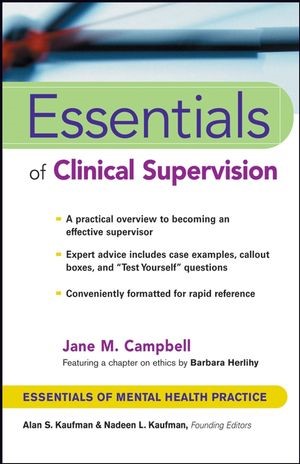


Clinical supervision, is an important aspect of mental health practice. Essentials of Clinical Supervision presents a comprehensive model and techniques for supervising mental health professionals individually and in groups, as well as peer supervision. A clear and accessible resource, it provides step-by-step guidelines for supervising begin-ning as well as advanced practitioners, along with proven tips for effective supervision, including how to give constructive feedback and how to apply coaching to motivate supervisees.
As part of the Essentials of Mental Health Practice series, this book provides informa-tion mental health professionals need to practice knowledgeably, efficiently, and ethical¬ly in today’s behavioral healthcare environment. Each concise chapter features numerous callout boxes highlighting key concepts, bulleted points, and extensive illustrative mate¬rial, as well as “Test Yourself” questions that help you gauge and reinforce your grasp of the information covered.
Essentials of Clinical Supervision covers basic skills such as goal setting, evaluation, building the supervision relationship, and solving problems. It also discusses specific supervision strategies such as teaching, mentoring, coaching, and consulting; explains how to document supervision; and describes specialized techniques, such as using video in supervision. Finally, it incorporates an important section on ethical, legal, multi-cultural, and crisis management issues that may arise when supervising others.
Essentials of Clinical Supervision supplies professionals and students in all mental health fields with a key resource for effective practice.
Jane M. Campbell, PhD, NCC, ACS, is a consulting psychologist in private practice in Houston, Texas.
Ethics chapter by Barbara Herlihy, PhD, University of New Orleans, New Orleans, Louisiana.
After completing this course you’ll be able to:
| 1. | State the primary purpose of clinical supervision. |
| 2. | Discuss the research related to training in supervision. |
| 3. | State the purpose of supervision. |
| 4. | Compare effective supervisory behaviors and personal qualities and characteristics. |
| 5. | State the first task of an effective supervisor. |
| 6. | Describe Bernard’s discrimination model. |
| 7. | State the components of supervision according to Haber (1996). |
| 8. | Describe the roles of a supervisor according to several theorists. |
| 9. | State the two main areas of learning and difficulty for the supervisee according to Altucher. |
| 10. | List several functions of a supervisor. |
| 11. | Compare the two systems theory concepts of Middleman and Rhodes. |
| 12. | Describe the Myers-Biggs Type Indicator. |
| 13. | Compare the behavioral models and cognitive models. |
| 14. | Compare the psychodynamic model and Adlerian model. |
| 15. | Compare the existential psychotherapy model and family therapy models. |
| 16. | Compare brief therapy and solution-focused therapy models. |
| 17. | Discuss the IPR and parallel process models. |
| 18. | Discuss the developmental models of supervision. |
| 19. | Describe how supervisors develop. |
| 20. | Define individual, group, peer and team formats. |
| 21. | List the main methods of supervision and state the one most common and why. |
| 22. | Discuss how to review tapes for supervision purposes. |
| 23. | Describe several methods for live supervision. |
| 24. | Describe the three main categories of supervision techniques and give examples. |
| 25. | Compare role conflict and role ambiguity. |
| 26. | Describe the family systems theory. |
| 27. | List several relationship skills of an effective supervisor. |
| 28. | Describe how a supervisor should work collaboratively. |
| 29. | Describe the variables when selecting methods and techniques for supervision. |
| 30. | Describe the six-stage model of change according to Prochaska. |
| 31. | Describe how a supervisor can work with a difficult supervisee. |
| 32. | State how the role of supervisor and supervisee create an ethical dilemma. |
| 33. | Define vicarious liability. |
| 34. | Discuss the four main areas of vulnerability for the supervisor in terms of the supervisee’s actions with client care. |
| 35. | Discuss the term "multicultural." |
| 36. | Discuss several administrative tasks in supervision. |
| 37. | Compare psychotherapy and supervision. |
| 38. | List several issues that limit personal development. |
| 39. | Compare compassion fatigue and burnout. |
| 40. | List the eight choices a person needs to make prior to supervising and the paperwork required. |
| 1. | What Is Supervision? |
| 2. | What Do Supervisors Do? |
| 3. | What Are the Models of Supervision? |
| 4. | What Are the Methods and Techniques of Supervision? |
| 5. | What Is the Role of the Relationship in Supervision? |
| 6. | How Does the Supervisor Select Methods and Techniques to Help the Supervisee Grow and Develop? |
| 7. | What Are the Ethical and Legal Issues in Clinical Supervision? |
| 8. | What Is the Role of Multicultural Issues in Supervision? |
| 9. | What Is the Role of Administrative Tasks in Supervision? |
| 10. | What Is the Role of Personal Development in Supervision? |
© 2007 - 2010 Homestead Schools, Inc. - Webmaster: ITSYS Solutions